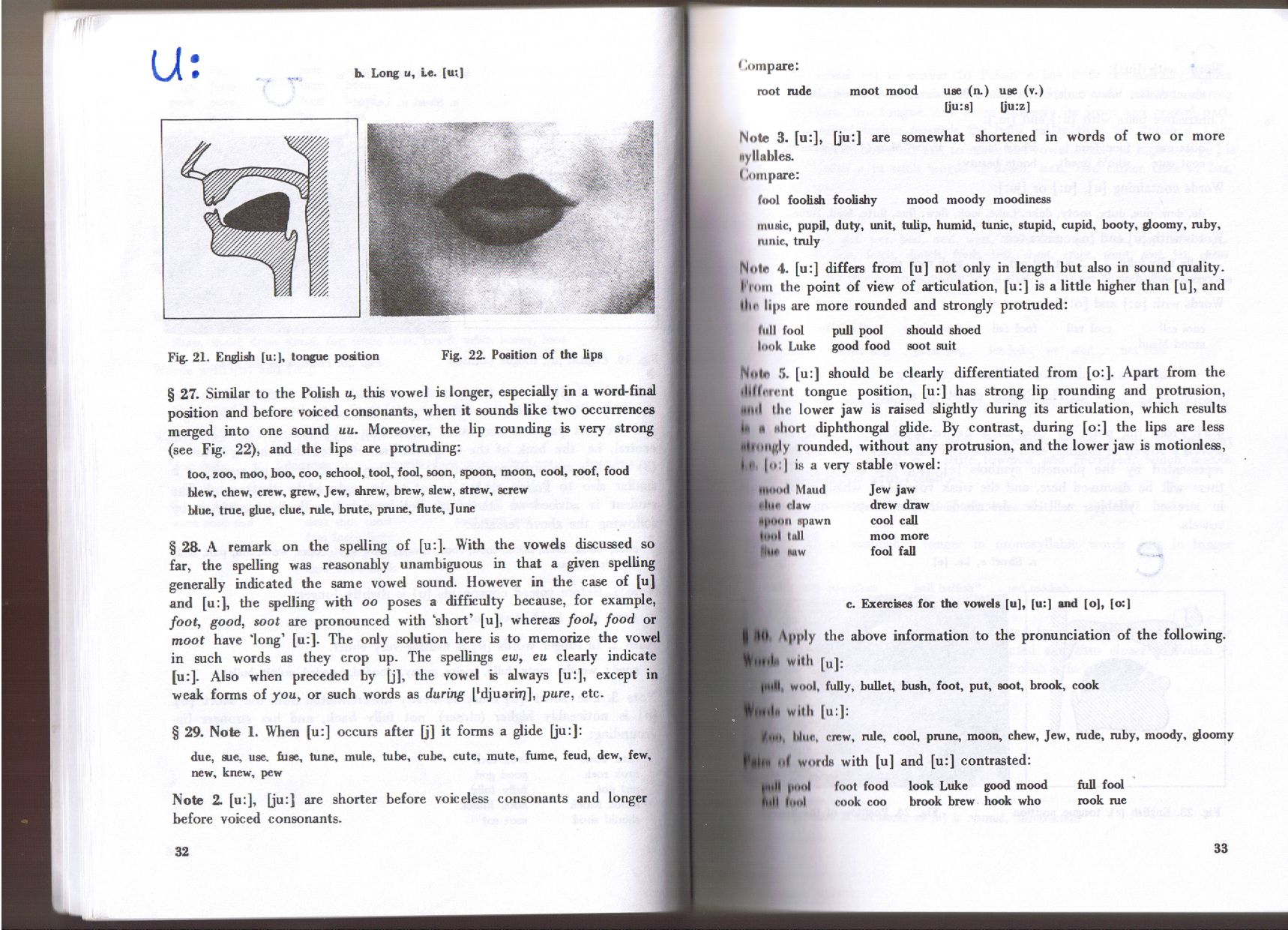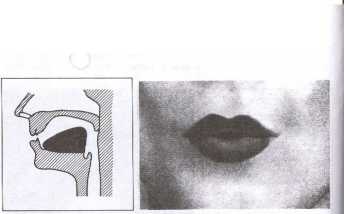CCF20100223�005


Fig. 21. Englńti [u:), lougue poation Fig. 2Z Position of the lips
§ 27. Similar to the Polish u, this vowel is longer, especially in a word-final position and before voiced consonants, when it sounds like two occurrences merged into one sound uu. Moreover, the lip rounding is very strong (see Fig. 22), and the lips are protruding:
too, zoo, raoo, boo, coo, school, tool, fool, soon, apoon, moon, coot, roof, food łdew, che w, erew, grew, Jew, ehrew, brew, alew, strew, acrew blue, true, glue, clue, rule, brute, prane, flute, June
§ 28. A remark on the spelling of [u:]. With the vowds discussed so far, the spelling was reasonably unambiguous in that a given spelling generally indicated the same voweł sound. However in the case of [u] and [u:], the spelling with oo poses a diffkulty because, for example, fool, good, sool are pronounced with ‘short’ [u], whereas fool, food or moot have 'long’ [u:]. The only solution here is to memorize the vowel in such words as they crop up. The spellings eui, eu clearly indicate [u:]. Also when preceded by [j], the vowel is always [u:], except in weak forms of you, or such words as during ['djuorir}], pure, etc.
§ 29. Notę 1. When [u:] occurs after [j] it forms a glide [ju:):
due, aie, use. fijse, tune, mule, tubę, cube, cute, mute, fume, feud, dew, few, new, knew, pew
Notę 2. [u:], [ju:] are shorter before vokeless consonants and longer before voiced consonants.
Compare:
root rude moot mood use (n.) use (v.)
[|u:s] lju:z]
Notę 3. [u:], [ju:] are somewhat shortened in words of two or morę syllables.
Compare:
fool foolish foolishy mood moody moodiness
musie, pupil, duty, unit, tulip, humid, tunic, stupid, cupid, booty, gloomy, ruby, I mnie, truły
Notę 4. [u:] differs from [u] not only in length but also in sound quality. Kmin the point of view of articulation, [u:] is a little higher than [u], and On' lips are morę rounded and strongly protruded:
fuli fool puli pool should shoed I look Lukę good food soot suit
Notę 5. [u:] should be clearly differentiated from [o:]. Apart from the illlwent tongue position, [u:] lias strong lip rounding and protrusion, sod the lower jaw is raised slightly during its articulation, which results
■ ■ short diphthongal glide. By contrast, during [o:] the lips are less ■łfoitgly rounded, without any protrusion, and the lower jaw is motionless,
|,i‘ |o ] is a very stable vowel:
V miH>d Maud Jew jaw
H rlur claw drew draw
I spoi *n npawn cool cali
■ Nur mw fool fali
c. Exercises for the vowels [u], [u:] and [o], [o:)
HQ, Apply the above information to the pronunciation of the following. ■his with [u];
I puli woni, fully, bullet, bush, foot, put, soot, brook, cook Wio.l. willi [u:]:
^■oo. Iiluc, erew, rule, cool, pnine, moon, chew, Jew, rude, ruby, moody, gloomy iw -I words with [u] and [u:] contrasted:
■kuli pool foot food look Lukę good mood fuli fool
^■łl fiinl cook coo brook brew hook who rook me
33
Wyszukiwarka
Podobne podstrony:
CCF20100223�005 u b. Long u, L«. (u:) Fig. 21. Engiiifi
CCF20100223�002 a b. Long a, Le.
CCF20100223�002 a b. Long a, Łe.
CCF20100223�007 Fig. 25. English
CCF20100223�016 Fig. 38a. English
CCF20100223�000 1. Short and long i ł Short i, te. (i
CCF20100223�016 Fig. 38a. English
image038 a Fig 10 Idea of the “World tree" as the “World axis" implemented m settlements o
Slajd66 Bielactwo - leczenie- terapia łączona_ Fig. 3.8.1 (a) Vitiljgo patehes of the face. (b) Glin
6 L. Starkel Fig. I. Ideał model of the organization of research in the national project MR 1 — 25 “
Fig 3. Superior view of the sellar region and its related bonę struć-tures. The arrow indicates the
Fig. 6 - Back analysis of the "Cannicella" landslide Fig. 5 - Scarp of the "Cannicell
Fig. 3 - Panoramie view of the Southern side of Orvieto Hill. The following can be noted in the
więcej podobnych podstron